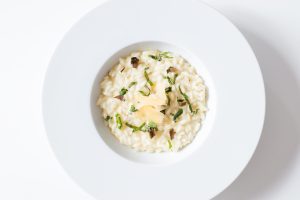Archive for the ‘Nutrition’ Category
Transform Your Life With Phytonutrients
December 30 2017
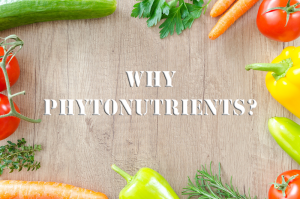 You’ve likely heard the word “phytonutrient” in the past, but there’s a good chance you don’t know what they are or why they are a vitally important component of good health and a good life. Once you learn what they are you may never look at food the same way again! Read on to find out just how powerful they are and help transform your health for the new year!
You’ve likely heard the word “phytonutrient” in the past, but there’s a good chance you don’t know what they are or why they are a vitally important component of good health and a good life. Once you learn what they are you may never look at food the same way again! Read on to find out just how powerful they are and help transform your health for the new year!
What Are Phytonutrients?
The first thing you may be wondering is what exactly are phytonutrients and why should you care about them?
Well, to explain simply, they are generally thought of as natural chemicals that food from plants are composed of. Generally these are found in foods that are fruits, vegetable, whole grains, nuts or legumes. In fact, the word “phyto” means “plant” in Greek.
These special nutrients help protect plant life from threats such as bugs, fungus and germs and consequently are also considered to be beneficial to protecting our own health; as well as prolonging our life when consumed.
There are over 25,000 types of phytonutrients, each with different properties and health benefits. Without getting too technical, they are for certain something you’ll want to ensure you eat enough of!
How To Use Them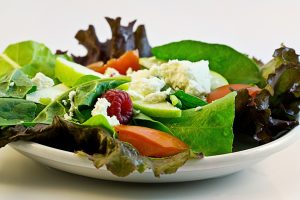
A good rule of thumb is to look for and consume fruits and vegetables with lots of color. Foods with color are full of positive benefits that your body can use to improve and maintain good health. Each time you eat, try to be conscious of the color of the foods you put in your mouth. If most of what you eat has little or neutral colors, then there’s a good chance they are lower quality foods that lack phytonutrients.
So maybe our mothers’ were right when they kept telling us to eat our fruits and vegetables!
Example Phytonutrients
Some of the more well-known phytonutrients include:
- Carotenoids are one category of phytonutrients that have many known benefits. Typically they provide the red, yellow and orange colors found in fruits and vegetables. They are known to provide an abundance of antioxidants that protect the cells in our body from damage.
- Flavonoids another type of phytonutrient category contain numerous health benefits including reducing the risk of asthma, reducing/preventing some types of cancer, reducing inflammation, preventing chronic diseases, and reducing risks of heart disease.
- Lycopene is a phytonutrient found in red and pink colored fruits and vegetables such as tomatoes, pink grapefruit and watermelon has particularly been linked to lower cases of prostate cancer.
- Resveratrol is another phytonutrient commonly found in grapes and products of grapes, such as red wine and grape juice. It is known to potentially help reduce incidents of heart disease and some types of cancer. Animal studies also show that it may aid in prolonging life.
There are so many it’s impossible to list them all, but these alone should demonstrate they should not be overlooked!
The Benefits
Phytonutrients provide so many advantages to your body that it’s impossible to list them all. Here are just a few benefits:
- Antioxidants are known to protect us from common health issues including Alzheimer’s disease, cancer, eye health, heart disease, Parkinson’s disease, along with many other conditions. In fact, many health experts believe that the aging process can be slowed by ensuring that one’s diet contains plenty of antioxidants!
- Immune system health is thought to benefit greatly when eating foods containing phytonutrients.
- Antibacterial/Antiviral properties are known to be present in foods high in phytonutrients.
- Hormones within the body are thought to be positively affected as well.
Important To Note
One thing to remember when it comes to phytonutrients is that you can’t cheat your way to including them in your diet. By this it means, that no supplement, pill or other trick will provide your body with phytonutrients! The only way to properly incorporate them in your life is to consumer healthy foods made of vegetables, fruits, whole grains, nuts and legumes.
Remember This!
When you shop AND eat, look for colorful ingredients, namely fruits and vegetables; which are in turn rich in phytonutrients.
The miraculous benefits they provide is nothing short of life changing if you learn to look out for them and use them daily at each meal.
We created MealEasy® with this in mind. To help anyone eat more health enriching foods, containing more phytonutrients and life changing health benefits.
For any easy way to start including more of these types of meals in your diet, consider joining MealEasy today. We built it for you and your health… Your body will thank you for it with better health, more energy and a positive outlook.
The Health Benefits of Wild Rice
May 17 2017
Wild Rice: A Nutritious and Tasty Alternative
It can sometimes be difficult finding ingredients that tick all the right boxes when it comes to taste, nutrition and affordability. And it is even more of a challenge if you are also having to take food intolerances or special dietary requirements into account. Yet wild rice could just be the answer to your prayers. If you’ve never cooked with it before, now could be the time to give it a try.
Contrary to what you might think, wild rice is not just a special variety of the white or brown rice with which you are familiar. In fact, it is not really a rice at all, but a type of aquatic grass. It contains no grain and no gluten, meaning it is even suitable for those with the strictest dietary constraints; essentially, wild rice is packed full of nutrients that we all need for a healthy body and immune system.
Rice That Is Not Rice
Wild rice is a term that is used to describe four distinct species of grass that are mostly native to North America. Its popularity has increased over recent years as people have got wise to its health benefits and rich, nutty flavor. The seeds are larger and more densely-packed with nutrients than conventional rice, meaning it packs a real punch from a nutritional perspective.
Ounce for ounce, it contains double the protein content of brown rice and more than ten times the selenium content – a vital mineral for the production of antioxidants that helps keep the body healthy and the immune system working properly.
Cooking With Wild Rice
Wild rice can be added to your regular diet as a substitute for white or brown rice as a healthy accompaniment to any meat, fish or vegetable dish. It is cooked in much the same way, but bear in mind that it will typically need at least 45 minutes boiling or steaming time, so schedule the rest of your dish accordingly.
It is also a great basis for a nutritious salad that is a little out of the ordinary, but is quick and easy to prepare.
The Next Great Superfood?
Healthy, nutritious and easy to prepare, yet tastes great and is suitable for those on a vegan, grain-free or gluten-free diet. It is easy to see why wild rice is gaining in popularity and being hailed as the latest superfood.
Join the revolution and try some today – you might never go back!
Cinnamon: A Simple Ingredient Can Have Incredible Power
March 21 2017
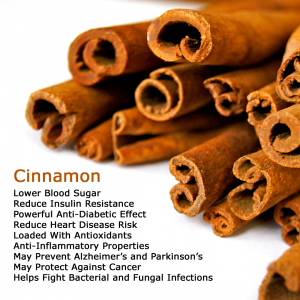 Did you know that cinnamon, a common ingredient that’s found in many of our own cupboards and used in many well know recipes, has some amazing properties!
Did you know that cinnamon, a common ingredient that’s found in many of our own cupboards and used in many well know recipes, has some amazing properties!
Just a few of the things it can do for your health includes:
- Lowering blood sugar
- Reducing insulin resistance, including powerful anti-diabetic effects
- Reducing heart disease risk
- Providing you with beneficial antioxidants
- Exhibiting anti-inflammatory properties
- Potentially helping to prevent Alzheimer’s and Parkinson’s disease
- Protecting against cancer
- Fighting bacterial and fungal infections
Recent studies also indicate it may be beneficial for those with HIV.
Wow! That’s a lot of punch in something so simple that we all take for granted in our everyday lives. The cure is really in our cupboard isn’t it!?
So the next time you look at your food, remember it’s more then just something you put in your mouth to feed hunger. The choices you make with your food can have dramatic effects on your health if used the right way.
We created MealEasy as a family with this in mind. If you would like to boost your health to new levels, please consider giving MealEasy a try. Whether you use it to make one meal or hundreds, you’ll be making a big impact on your well-being!
Please follow us on Instagram, Facebook, or Twitter for more helpful posts!
5 Tips For Planning And Sticking To A Healthy Diet
July 01 2016
We all know the countless benefits of eating healthy. A well-balanced diet is imperative to losing weight. But that’s not all.
A nutritious diet is the secret to glowing, radiant skin. Not to mention, consuming a balanced diet that is rich in vitamins, minerals and nutrients boosts brain and heart function, and prevents diabetes.
What you eat has a substantial impact on your health. In fact, your food choices can even change your outlook on life. If you want to look and feel good, it’s crucial to adopt a healthy, balanced dietary routine. In other words, focus on fruits and veggies, low-fat dairy, protein, and good fats.
But planning and sticking to a balanced diet is easier said than done. In order to assist you, here are 5 tips you should follow:
Simplify your meals
Don’t obsess over calories at this point. Instead, choose foods and drinks based on freshness and variety. Eating a variety of foods will ensure that you get all nutrients and vitamins. Moreover, it will limit your exposure to harmful substances in a particular food.
Similarly, opt for fresh ingredients. Avoid processed food as they contain toxic ingredients that are detrimental to your health.
 Plan and prepare meals in advance
Plan and prepare meals in advance
Develop a workable game plan. Be realistic. Plan and prepare your meals accordingly.
Take advantage of MealEasy’s eating plans to cook scrumptious, yet wholesome, meals on time and within your budget.
You can use MealEasy’s balanced meal plan to search for recipes, track nutritional values, shop for ingredients and prepare meals based on your individual preferences and health and dietary goals.
Rotate your meals
Alongside meal planning, try to mix up your meals to prevent boredom. Also remember to experiment with a variety of healthy ingredients.
For example, if you want to add greens to your meal, think beyond lettuce or broccoli. There are plenty of other options to choose from, such as Chinese cabbage and Kale.
Aim for balance
Have three healthy meals every day. Healthy snacks are just as important. Remember to have breakfast to boost your metabolism and energy.
In addition, avoid eating at night. Aim to eat dinner early for proper digestion of food. Most importantly, listen to your emotions and body. Be mindful of what you eat; don’t feed your feelings.
Have smaller portions and take time to enjoy your meal. Stop eating when you feel full.
Practice moderation
Last, but not least, eat in moderation. Don’t have too little or too much of a certain food. Even if it’s sweets, have smaller portion to satisfy your craving. Don’t ban any single food.
Follow these simple tips to live a happy, healthy life!
What do kids really want to eat?
October 10 2013
We get asked all the time here at MealEasy if we have any “kid friendly meals”. And to be honest, we’re often at a loss on how to answer this question.
What defines a “kid friendly meal”?
- Is it something nutritious?
Then yes we have those. - Is it something quick to prepare?
Yes, we have those meals too. - Is it something straight out of a package or from a fast food joint?
Then NO; those we don’t have.
This awesome video explains how we’ve been coerced into believing that sugar coated cereals and fat laden burgers and fries are what every kid wants. It’s great viewing and may change your mind about what is a “kid friendly meal”.
http://www.youtube.com/watch?v=PWOcP-bXuO8
Weight Maintenance Strategies from a Dietitian
June 21 2013
Guest Blog by Angela Dufour, MEd., PDt., IOC Dip Sports Nutrition, Nutrition in Action and Author of PowerFUEL Food: Planning Meals for Maximum Performance
As a dietitian, I regularly see clients who may easily be able to maintain healthy body weights, as well as those who struggle to reach a healthy weight. Although everyone is different and there isn’t one guaranteed, no-fail method to weight loss or maintenance, there are certain dietary approaches supported through research which can assist us in achieving a healthy weight.
Topping the list of helpful weight maintenance strategies is appropriate meal planning. Because let’s face it, we all know what it’s like to have a long, hectic day at work or a week with more things going on than hours to do them. Whenever this happens, we often find ourselves too busy and too tired when meal times roll around.
The daily rush can potentially lead to developing poor nutrition habits such as compensating pre-planned, well-balanced meals for quick and simple fixes like fast food restaurants, take-out, and processed convenience foods. Not only does this become costly, it can lead us to consume more than our adequate amount of calories, as well as higher amounts of saturated and trans fats, salt, and added sugars – additives that should be limited if we’re looking to achieve a healthy diet.
Cooking Fiddleheads
May 28 2013
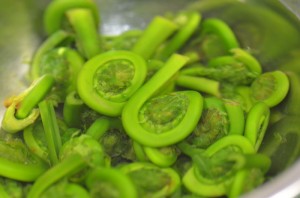 Fiddleheads are the furled fronds of a young ostrich fern commonly found near rivers and streams. Because they cannot be cultivated, fiddleheads are only available for a few weeks every spring and are harvested before the fern unrolls completely. The ostrich fern grows wild in certain parts of North Eastern North America and is the variety most likely to be on tables here. Fiddleheads are an excellent source of Omega 3 and Omega 6 as well as iron and fibre. Imagine a combination of asparagus, broccoli and green beans and you’ll get the flavour of fiddleheads.
Fiddleheads are the furled fronds of a young ostrich fern commonly found near rivers and streams. Because they cannot be cultivated, fiddleheads are only available for a few weeks every spring and are harvested before the fern unrolls completely. The ostrich fern grows wild in certain parts of North Eastern North America and is the variety most likely to be on tables here. Fiddleheads are an excellent source of Omega 3 and Omega 6 as well as iron and fibre. Imagine a combination of asparagus, broccoli and green beans and you’ll get the flavour of fiddleheads.
Cleaning Fiddleheads
Fiddleheads can be cleaned by first placing them in a colander and thoroughly rinsing them off with clean cold water. After washing, place the rinsed fiddleheads in a bowl full of clean cool water to remove the remainder of the brown papery coverings, and repeat as needed. They should appear clean at this point.
Short-term storage
Keep fiddleheads refrigerated until you are ready to cook or preserve them. They can be stored in the refrigerator for up to two weeks in a container filled with water. Make sure to change the water in the container every couple of days.
Cooking Fiddleheads
Fiddleheads can be cooked using two different methods, boiling and steaming.
- Boiling
Bring lightly salted water in a pot to a rolling boil and add washed fiddleheads without stopping the boil. If the water stops boiling you added too many fiddleheads. Therefore, make sure to boil them in enough water. If the water loses its boil, don’t worry, simply bring the water back to a steady boil and cook for 15 minutes.
- Steaming
Bring a small amount of water to a boil preferably in steamer. Add cleaned fiddleheads and steam for 10-12 minutes. Continue reading
Fast, Fresh & Easy Lunch Idea
May 22 2013
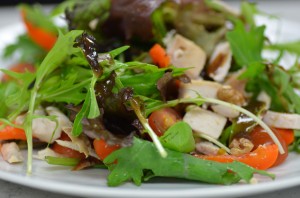 Do you think you’re getting the “healthy option” when ordering a salad from a fast food joint? Think again.
Do you think you’re getting the “healthy option” when ordering a salad from a fast food joint? Think again.
While some salads may offer less fat and calories than other menu items, often adding a bit of grilled chicken on your salad will make it as fat filled as a double Quarter Pounder with cheese!
Even if you do choose one of the “healthier” salad options, quite often you’re overwhelmed with sodium that’s three times the suggested meal amount of 480mg.
Do you want to eat a healthy salad for lunch? Then make it at home and brown bag it. That’s the only way you know what’s in your lunch. Don’t have time to make a salad in the morning? Then plan ahead! Last night’s leftover roast chicken will be great on mixed greens. Top the fresh greens with some cherry tomatoes and some toasted walnuts (toasted on the weekend and kept in the fridge for future use).
Add a little homemade balsamic dressing and bring it along to work with you, and you’ve got yourself a tasty and above all else, HEALTHY salad.
Oh…and that was MUCH FASTER than waiting in line at the fast food counter too!
Time to make: under 5 minutes
Cost: Less than $2.50
Calories: under 300
Chef Paul’s Pantry Essentials
March 11 2013
 There are a few essential ingredients that no pantry should be without. Whenever you want to put together a quick snack or meal, these ingredients will help get you on your way:
There are a few essential ingredients that no pantry should be without. Whenever you want to put together a quick snack or meal, these ingredients will help get you on your way:
Extra Virgin Olive Oil
This “healthy fat” is wonderful for everyday cooking. Extra virgin olive oil is a great substitute for butter or margarine. Use it also for sautéing onions and garlic, drizzling over salads, add it to a bruschetta mixture, and more.
Spring is Near – Grow Fresh!
March 06 2013
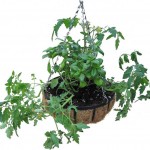 Even if you’ve never gardened before or you think you don’t have a green thumb, growing your own food can be simple and economical. A huge bonus for your bank account!
Even if you’ve never gardened before or you think you don’t have a green thumb, growing your own food can be simple and economical. A huge bonus for your bank account!
Despite what most people think , you don’t need large plot of land to grow a kitchen garden. All you need is soil, light and the ability to water the plants on a regular basis. Growing herbs on a windowsill, in pots on your veranda, or hanging tomato baskets from your balcony is an easy way to cut your food bills.
Cooking with fresh herbs adds wonderful flavor to most dishes but buying a bunch of thyme when you know that you only need a small amount of chopped thyme can sometimes be wasteful. Growing thyme, basil, cilantro and other herbs can be easy, fun and a money saver.
Children who grow up learning about the connection between growing food and eating food, have a better understanding of the importance of a healthy, nutrient rich diet. Get the kids involved and let them have their own indoor garden pots.
Check out this site for more information on growing your own herbs indoors: Container gardening

